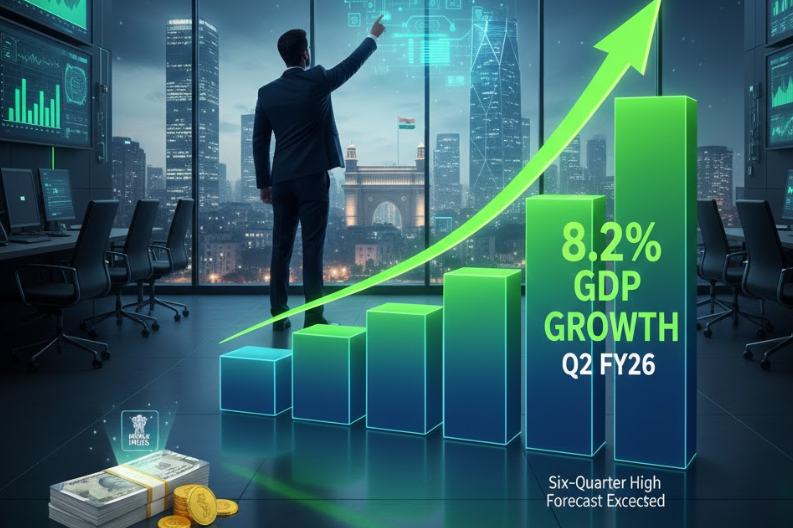India GDP growth recorded an impressive 8.2% in the July-September quarter of the financial year 2025-26, marking a six-quarter high. The Ministry of Statistics and Programme Implementation released these figures Friday, significantly beating economist predictions and Reserve Bank of India forecasts.
The growth rate substantially exceeded expectations. Fifteen economists polled by Mint had forecast 7.2% growth, with projections ranging from 7% to 7.7%. Moreover, the RBI had projected just 7% for this quarter. Consequently, this 1.2 percentage point surprise may influence the central bank’s December policy meeting decisions regarding rate cuts.
Manufacturing emerged as a major contributor, growing 9.1% year-on-year compared to 7.7% in the previous quarter. Additionally, construction activity expanded 7.2%, maintaining robust momentum. The tertiary sector showed exceptional performance at 9.2%, with financial and real estate services jumping 10.2%.
Furthermore, private consumption expenditure rose 7.9% during the quarter, up from 6.4% in the same period last year. This consumption surge reflected improved household spending patterns. However, government spending declined 2.7% compared to a 7.4% increase in the previous quarter.
Several factors contributed to this strong performance. A low base effect played a significant role, as GDP growth was only 5.6% in the same quarter last year. Subsequently, low inflation conditions also helped push growth higher. Nominal GDP grew 8.7% during the September quarter, indicating healthy underlying economic activity.
Real GDP has been estimated to grow by 8.2% in Q2 of FY 2025-26 against the growth rate of 5.6% during Q2 of FY 2024-25: Govt of India pic.twitter.com/zOT2BUwTHt
— ANI (@ANI) November 28, 2025
The economy expanded 7.8% in the first quarter of FY26. Consequently, the first-half growth rate stands at 8.0%, substantially higher than 6.1% in the corresponding period last year.
The secondary sector grew 8.1%, driven primarily by manufacturing and construction. Meanwhile, agriculture and allied sectors showed moderated growth at 3.5%. Similarly, electricity and utility services expanded 4.4%, reflecting slower momentum in these areas.
Interestingly, high-frequency indicators showed improved momentum even before GST rate cuts took effect on September 22. The tax reductions covered hundreds of items, from soaps to small cars, aiming to spur domestic production.
Despite strong growth, India faces external headwinds. The United States imposed 50% tariffs on Indian exports in August due to import barriers and Russian oil purchases. However, the impact hasn’t meaningfully affected quarterly growth figures yet.
President Donald Trump cited these tariffs as necessary due to India’s trade practices. Nevertheless, the Indian economy demonstrated remarkable resilience against these challenges.
The RBI projects 6.8% growth for the full year, with 6.4% for Q3 and 6.2% for Q4. However, economists now expect upward revisions following this strong performance. Garima Kapoor from Elara Securities attributed growth to front-loaded exports and strong government capital expenditure.
Additionally, Suvodeep Rakshit from Kotak Institutional Equities predicts Q3 will show strong growth again. Festive-season demand and pent-up consumption should support continued momentum. He projects full-year growth averaging around 7.5%.
To achieve “Viksit Bharat” status by 2047, India needs sustained 8% growth over two decades. The Economic Survey 2024-25 emphasized this requirement. Similarly, the World Bank suggests India must grow 7.8% annually over 22 years to become a developed nation.
In conclusion, India GDP growth demonstrates strong fundamentals despite global uncertainties. The combination of robust manufacturing, healthy consumption, and supportive policies positions the economy well for sustained expansion ahead.



